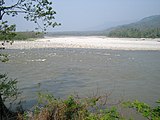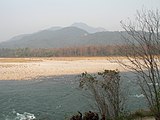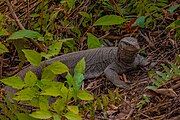Manas National Park
| Manas National Park | |
|---|---|
| Manas Biosphere Reserve | |
Ministry of Environment and Forests, Government of India | |
Asia-Pacific | |
| Endangered | 1992–2011[1] |
Manas National Park (
Origin of the name
The name of the park is originated from the Manas River. The Manas river is a major tributary of Brahmaputra River, which passes through the heart of the national park.
History
The Manas National Park was declared a sanctuary on 1 October 1928 with an area of 360 km2 (140 sq mi). Manas bio reserve was created in 1973. Prior to the declaration of the sanctuary, it was a reserved forest called Manas R.F. and North Kamrup R.F. It was used by the Cooch Behar royal family and Raja of Gauripur as a hunting reserve. In 1951 and 1955, the area was increased to 391 km2 (151 sq mi). It was declared a World Heritage Site in December 1985 by UNESCO. Kahitama R.F. the Kokilabari R.F. and the Panbari R.F. were added in the year 1990 to form the Manas National Park. In 1992, UNESCO declared it as a world heritage site in danger due to heavy poaching and terrorist activities. On 25 February 2008, the area was increased to 500 km2 (190 sq mi). On 21 June 2011, it was removed from the List of World Heritage in Danger and was commended for its efforts in preservation.[5]
Human history
There is only one forest village, Pagrang, in the core of the national park. Apart from this village 56 more villages surround the park. Many more fringe villages are directly or indirectly dependent on the park.
Geography
Political Geography: The park area falls in the following districts: Chirang, Baksa in the autonomous territorial region, i.e BTR in the state of Assam in India.

The park is divided into three ranges. The western range is based at Panbari, the central at Bansbari near Barpeta Road, and the eastern at Bhuiyapara near Pathsala. The ranges are not well connected; while two major rivers need to be forded in going from the centre to the Panbari, there is a rough trail (the Daimari road) connecting the centre to the eastern range. Most visitors come to Bansbari and then spend some time inside the forest at Mathanguri on the Manas river at the Bhutan border.
Physical Geography: Manas is located in the foothills of the
Climate: The minimum temperature is around 15 °C (59 °F) and the maximum temperature is around 37 °C (99 °F).
Heavy rainfall occurs between May and September. The annual average rainfall is around 333 centimetres (131 in).
Natural history

Biomes
There are two major biomes present in Manas:
- The grassland biomes : wild Asian buffalo, etc.
- The forest biomes : Malayan giant squirrel or black giant squirrel, Chinese pangolinetc.
Flora

Vegetation: The monsoon forests of Manas lie in the Brahmaputra Valley semi-evergreen forests ecoregion.[6] The combination of Sub-Himalayan Bhabar Terai region with riverine succession leading up to the Himalayan subtropical broadleaf forests makes it one of the richest biodiversity areas in the world.
The main vegetation types are:
- Sub-Himalayan light alluvial semi-evergreen forests in the northern parts.
- East Himalayan mixed moist and dry deciduous forests (the most common type).
- Low alluvial savanna woodland, and
- Assam Valley semi-evergreen alluvial grasslands which cover almost 50% of the park.
Much of the riverine dry deciduous forest is at an early successional stage. It is replaced by moist deciduous forest away from water courses, which is succeeded by semi-evergreen climax forest in the northern part of the park. A total of 543 plants species have been recorded from the core zone. Of these, 374 species are dicotyledons (including 89 trees), 139 species monocotyledons and 30 are pteridophytes and gymnosperms.
The park's common trees include
Fauna

The sanctuary has recorded 55 species of mammals, 380 species of birds, 50 of reptiles, and 3 species of amphibians. Out of these wildlife, 21 mammals are India's Schedule I mammals and 31 of them are threatened.
The fauna of the sanctuary include
.The park is well known for species of rare and endangered wildlife that are not found anywhere else in the world like the Assam roofed turtle, hispid hare, golden langur and pygmy hog.
The Manas hosts more than 450 species of birds..
Gallery
-
Beki River
-
Elephant
-
View of the mountains
-
Hog Deer
-
A reptile of Manas
-
Herd of elephants in Manas
-
Herd of buffaloes in the park
See also
References
- ^ Successful preservation of India's Manas Wildlife Sanctuary enables withdrawal from the List of World Heritage in Danger at UNESCO website
- ^ "WWF - Royal Manas National Park, Bhutan". Archived from the original on 7 November 2009. Retrieved 4 April 2010.
- ^ Choudhury, A.U.(2010)The vanishing herds : the wild water buffalo. Gibbon Books, Rhino Foundation, CEPF & COA, Taiwan, Guwahati, India
- ^ "Manas Wildlife Sanctuary". UNESCO World Heritage Convention. United Nations Educational Scientific and Cultural Organization. Retrieved 3 June 2023.
- ^ Amelan, Roni. "Successful preservation of India's Manas Wildlife Sanctuary enables withdrawal from the List of World Heritage in Danger". Retrieved 21 June 2011.
- Washington, DC. pp. 300-301
- PMID 15567254.
- ^ Choudhury, A.U. (2006) Birds of Manas National Park. Gibbon Books & The Rhino Foundation for Nature in North East India, Guwahati, India. 84pp







